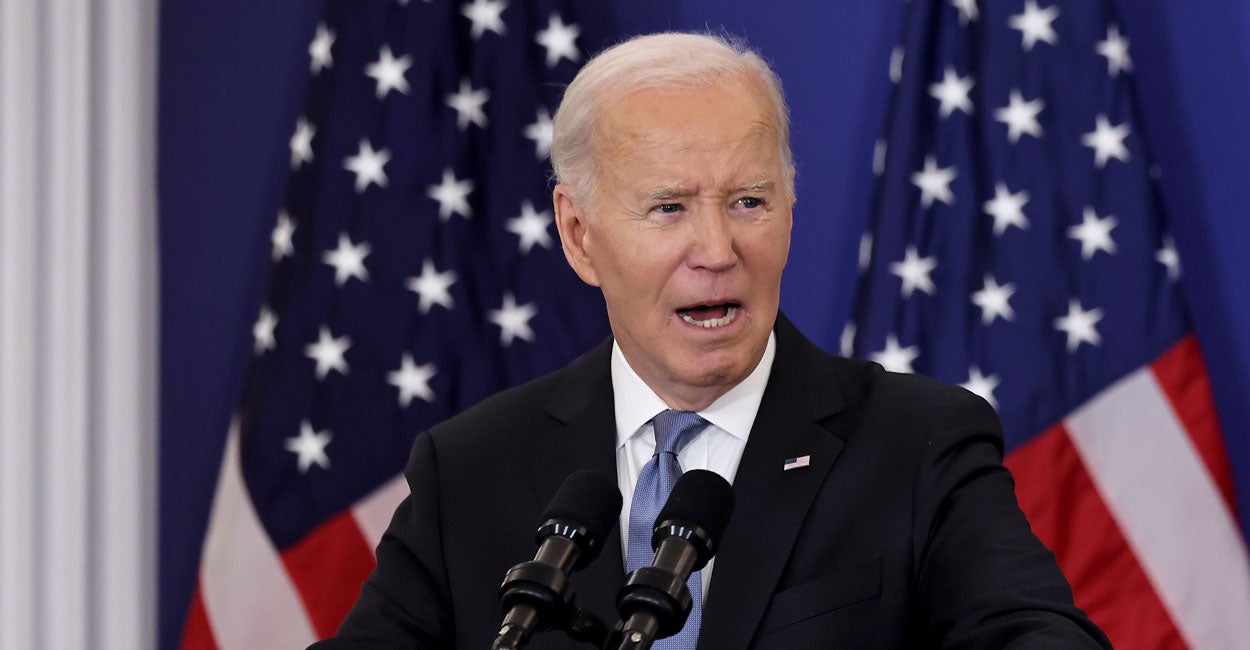U.S. wasting billions on dead and violated arms control agreements
Biden-Harris belief that these are a solution 'is pollyannish'



Contrary of the illusions of the Arms Control Association, the current situation as stated by senior White House official Pranay Vaddi in June 2024, is that, “Russia, the PRC [China] and North Korea are all expanding and diversifying their nuclear arsenals at a breakneck pace—showing little or no interest in arms control.” In August 2024, Acting Assistant Secretary of Defense for Space Policy Vipin Narang observed that “…we now find ourselves in nothing short of a new nuclear age—an unprecedented mix of multiple revisionist nuclear challengers who are uninterested in arms control or risk reduction efforts.”
Nonetheless, the Biden Administration continues to believe that there is an arms control solution to our security problems. This is pollyannish. The United States faces more than a refusal to negotiate. The record of Russian (and before it Soviet) compliance with arms control agreements is extremely poor. In 1987, President Ronald Regan told the Congress that, “The Administration’s most recent studies support its conclusion that there is a pattern of Soviet noncompliance. As documented in this and previous reports, the Soviet Union has violated its legal obligation under, or political commitment to, the SALT I ABM Treaty and Interim Agreement, the SALT II Agreement, the Limited Test Ban Treaty of 1963, the Biological and Toxin Weapons Convention, the Geneva Protocol on Chemical Weapons, and the Helsinki Final Act. In addition, the USSR has likely violated provisions of the Threshold Test Ban Treaty.” In 2023, the bipartisan Commission on the Strategic Posture of the United States pointed out that “…there is no prospect of a meaningful arms control Treaty being negotiated with Russia in the foreseeable future,” and, “Over the past 20 years, Russia has either violated or has failed to comply with nearly every major arms control treaty or agreement to which the United States is or was a party.”
The recognition of Russian arms control misconduct has become somewhat bipartisan. The Obama Administration concluded Russia was in violation of the INF Treaty. (The evidence was so strong that the entire NATO alliance characterized Russian actions not only as violations but as a “material breach” of the INF Treaty.) Additionally, the Biden Administration determined that Russia was in violation of the New START Treaty.[1]
When nuclear arms control negotiations were started in the late 1960s, it was assumed that any serious violation of the resulting agreements would result in their prompt termination. In his quasi-official history of the SALT I negotiation, written largely as a response to the classic critique of SALT I authored by the late Dr. William Van Cleave who participated in the SALT negotiation, John Newhouse was given access to the classified negotiating record. He wrote that “…any violation of the spirit of this language, let alone its letter, would probably oblige the United States to withdraw from the agreements. Moscow understands this.”[2] Unfortunately, the Soviet Union did not. The United States continued to comply with SALT I until a 1986 Reagan Administration decision to end compliance with SALT I and SALT II because of multiple serious Soviet violations. By then, both agreements had expired.
Despite the recognition that Russia is violating its arms control obligations, there is no consensus on what should be done about it. Arms control advocates have generally opposed doing anything significant about the violations irrespective of how serious they are, and they have been largely successful. Only President Ronald Reagan and President Donald Trump terminated arms control agreements in response to serious Soviet and Russian violations.
The ghost of dead and violated arms control agreements continues to impact U.S. national security policy. If Russia or China were to initiate the use of tactical nuclear weapons in support of aggression, a major contributing factor to the failure of deterrence would be dead and violated arms control agreements. The 1991/1992 Presidential Nuclear Initiatives (PNIs) eliminated almost all types of U.S. tactical or non-strategic nuclear weapons with the exception of a small number of nuclear bombs. Russia’s violations of the PNI commitments created the current massive imbalance that exists in these weapons which is illustrated in this linked NATO graphic:
The handling of this issue by the U.S. government is unfortunately typical of the way it usually treats arms control violations. Recognition of the violations of the PNIs first appeared in the 2020 edition of the State Department’s compliance report. Yet, in 2004, then-Assistant Secretary of State Stephen Rademaker voiced concern that Russia “has not fully met its commitments to reduce tactical nuclear weapons in Europe.” To this date, the United States has done nothing to respond to the PNI violations.
The ghost of the PNIs prevents the United States from exploiting the potential of dual capability (nuclear and conventional warheads) to reduce defense costs. While there is a cost of having dual capability, it is much cheaper than developing separate nuclear and conventional missiles, which the United States now does. The United States retained dual capability only in aircraft. This was also the product of the violated INF Treaty which had eliminated (or more accurately the United States believed had eliminated)[3] all INF missiles.
The same thing happened regarding continued Russian nuclear testing. It was also first reported in the 2020 version of the State Department’s compliance report. Yet, it was discussed in Russian press reports going back to the 1990s. The 2009 United States Strategic Commission report stated, “Apparently Russia and possibly China are conducting low yield tests.” The State Department’s annual compliance report did not treat the evidence of Chinese nuclear tests until the 2020 edition. Because it is not conducting nuclear tests, the United States pays an enormous price both in terms of dollars and reduced reliability of its nuclear deterrent.
The United States appears to have learned nothing from Russian arms control violations. The Biden Administration is still asking Russia to engage in negotiations aimed at a new nuclear arms control agreement. During the Biden Administration, Russia has consistently refused to negotiate. Perhaps it is time to recognize that the art of the deal does not entail seeking new agreements with nations that routinely dishonor their obligations.
There are some undesirable consequences of nuclear arms control. Even ignoring the compliance issue, one of the most pressing needs is protecting the U.S.’ conventional capability. Russia seeks to avoid limits on its nuclear capability but targets U.S. conventional weapons capability. There is an inherent conflict between effective verification of nuclear arms control and undesirable restrictions of conventional capability.
The START and INF Treaties, in combination, eliminated most options for U.S. conventional ballistic missiles and, in the case of the INF Treaty, also ground-launched cruise missiles. The option for long-range conventional air-launched cruise missiles was protected in START and New START, but even here arms control drove up the costs. To comply with the treaties, the United States was forced to design and procure nuclear and conventional cruise missiles (ALCMs) separately (no dual capability, i.e., conventional and nuclear warheads on the same missile) so that the option of deploying conventional long-range cruise missiles on fighters would be preserved. Russia apparently avoided the costs by violating the Treaties.
Russian state media have reported that the Russian Tu-22M3M Backfire bomber, which is not a heavy bomber under the New START Treaty and, hence, can’t carry long-range (600-km or more) nuclear-capable ALCMs, can carry the long-range nuclear-capable Kh-32, the Kh-555 and the Kh-101 ALCMs with ranges between 1,000-4,500 km. Interfax, Russia’s main non-governmental news agency, reports that the Russian Zircon (Tsirkon) hypersonic cruise missile will be carried by the Backfire bomber.[4] The Zircon is reportedly nuclear-capable and Russia has said it has a range of over 1,000-km.
It is unlikely that these issues will ever be discussed in a State Department arms control compliance report because they strike at the heart of the traditional approach of arms control advocates, including those in the Biden Administration. Russian arms control compliance is literally compliance to the extent convenient. The Russians are well aware that it is unlikely that the United States will seriously react to their arms control violations.
As a result of a late U.S. concession in the INF Treaty negotiations, conventional ground-launched INF-range missile systems (500 to 5500-km) were prohibited by the Treaty. A legacy of this now defunct treaty (terminated by President Trump due to Russian violations) is a massive Chinese advantage in ground-launched INF-range missiles.
The option of conventional hypersonic missiles was preserved in the original START Treaty while the New START Treaty prohibits very little. However, the cheapest fast strike options, such as ballistic missiles, are significantly impacted by legacy arms control.
The frequent failure to distinguish between conventional and nuclear ballistic missiles with regard to arms control limitations and prohibitions has served as a strong deterrent for U.S. exploitation of cheaper (in comparison to hypersonic missiles) conventional ballistic missiles of more than very short-range. Today, the U.S.’ conventional ballistic missile capability is limited to the 300-km range Army Tactical Missile System (ATACM) missiles.
In addition to the actual limitations of the treaties and the problem of Russian noncompliance with them, misperceptions of their content appear to be still influencing U.S. programmatic decisions. Aerospace Journalist David Ash writes, “If the B-1 could haul nukes, it would represent a violation of the last major arms-control accord between Washington and Moscow [the New START Treaty].” (Emphasis in the original). (It appears that the Air Force is operating on this same misperception.) This confuses the START II Treaty which prohibited the B-1 bomber from having a nuclear capability (but never entered into force) with the New START Treaty. This is a classic example of U.S. national security policy being shaped by the provisions of dead arms control treaties. Nuclear capable B-1s would have to fit into the New START Treaty limit on deployed nuclear delivery vehicles, but there is nothing in New START to prevent restoring a nuclear capability to at least some of these bombers. Moreover, the New START Treaty expires in early 2026.
B-1s could be cheaply restored to nuclear capability but they would need to be upgraded to deal with advanced air defenses or be provided with advanced nuclear-capable cruise missiles or nuclear-capable ballistic missiles. Indeed, Congress is now pressing to retore a nuclear capability to B-52 bombers that were denuclearized under the New START Treaty.
The New START Treaty unintentionally[5] opened up the option for unlimited air-launched ballistic missiles but this has only been exploited by Russia in its dual-capable (nuclear and conventional) Kinzhal “hypersonic” missile, which is actually a ballistic missile with some maneuverability. (The Chinese, unhindered by arms control, have also fielded dual-capable air-launched ballistic missiles.)
Until Russia and China developed them, there was relatively little interest in hypersonic weapons in the Defense Department due to their cost, inadequate defense budgets and perhaps post Cold War illusions concerning the benign nature of Russia and China (i.e., the end of history). In October 2021, then-Vice Chairman of the Joint Chiefs of Staff General John Hyten stated that the United States had conducted nine hypersonic missile tests in the last five years, whereas the Chinese have conducted ‘hundreds’.” Until it became obvious that the United States was well behind and these weapons constituted a serious threat, United States funding of hypersonic missiles was limited to low-budget R&D programs with limited results.
While hypersonic missiles are a considerable threat, ordinary Chinese ballistic missiles probably pose a much greater one because China has thousands of them. The legacy of dead and violated arms control agreements with Russia is preventing the United States from pursuing the most cost effective approach to dealing with the now massive and growing dual-capable Russian and Chinese missile threats. The perverse effects of dead and violated arms control agreements are that the United States has adopted the most expensive approach to obtaining fast flying missiles at the very time that U.S. defense spending has reached a low point in post-Korean War funding as illustrated by the linked Department of Defense Chart.
Except for the shortest range missiles, all ordinary ballistic missiles travel at hypersonic speeds. The ballistic trajectory they follow is longer than the distance flown by a hypersonic missile operating in the upper atmosphere. Hence, a ballistic missile takes longer to reach its target although the difference is generally only measured in minutes in theater-range missiles.
Bill Sweetman, a former Aviation Week journalist and a senior analyst with Northrop, has written a very interesting article on hypersonic missiles. He pointed out that because of the serious problems of operating in the atmosphere for long time periods at hypersonic speeds (Mach 5 or faster) the Navy hypersonic program reportedly results in a missile that weighs “7400kg to deliver a small 225 kg payload over 3000 km.” He noted that it is expected to cost $50 million per round and limits the number of ships that can carry them to platforms that are few in number and very expensive. He asks “how important is it to exceed Mach 5, compared with speeds of Mach 3.5 to 4 that can be attained with less risky ramjets?” Sweetman said that a 2013 Air Force study concluded that “…with modest stealth measures, a high-supersonic vehicle is as survivable as a hypersonic one. Moreover, the combination of high Mach and reduced radar cross section was demonstrated more than 60 years ago.”
Similarly, the technology for ballistic missiles was first developed in the 1950s and the 1960s while the technology for hypersonic missiles is still in the developmental stage. Both types use similar guidance technology which permits precision conventional strikes.
Hypersonic missiles clearly have certain advantages over supersonic missiles and ballistic missiles. They have shorter time of flight (which can be very important against mobile targets)
and they are more difficult to intercept than ballistic missiles. Against heavily defended targets, hypersonic missiles could be very useful. However, using a $50 million dollar missile to deliver a single light warhead 3,000-km is very expensive even if the warhead was nuclear. Nuclear-armed hypersonic missiles pose the threat of national leadership decapitation, something Russia has threatened. While the United States has been interested in conventional decapitation of terrorist leadership, nuclear decapitation of an adversary’s state leadership is something that is much less significant for the Untied States. The United States focuses on deterrence, not pre-emptive nuclear attack. Indeed, the current U.S. nuclear modernization program apparently does not include any nuclear-capable hypersonic missiles or, indeed, any supersonic aerodynamic nuclear weapons delivery capability other than the F-35A, which has only recently become nuclear-capable. Currently, the United States does not even have a supersonic long-range conventional missile.
Regarding arms control treaties, in the event of serious violations (i.e., material breaches) these agreements should be promptly terminated and unilateral compliance with them ended. This would open the option of much cheaper types of conventional fast flyers in the form of ballistic missiles. In view of the relatively poor performance of Russian air defense in the Ukraine conflict, this may be all that is necessary to destroy most targets on a timely basis. This would be particularly true if the ballistic missiles carried relatively simple and cheap missile defense countermeasures.
In the Ukraine war, Russian air defenses, including the vaunted S-400 system, have performed to a lesser level that they were expected to. This allowed relatively low performance Ukrainian cruise missiles to sink the Moskva, the flagship of the Russian Black Sea Fleet. The Russian S-400 has been penetrated by very short-range M-31 rockets. The S-400 is advertised for sale as able to intercept 4.8-km a second targets (about 3,000-km range ballistic missiles) but has been able to intercept only a fraction of the much slower (Mach 2.5 or just under a kilometer per second) M-31 missiles.[6] In late 2023, Britain said that at least three Russian S-400 systems have been destroyed or damaged by U.S. short-range ATACM missiles.[7] In April 2024, ATACMs reportedly destroyed an S-400 system. By May 2024, open source evidence confirmed that at least six advanced Russian air defense systems have been destroyed or damaged by relatively low performance short-range U.S. provided missiles.[8] In May 2024, reportedly ten ATACM missiles destroyed a Russian S-400 system deployed in Crimea. In June 2024, ATACMs reportedly struck three S-400 and S-300 air defense sites in Crimea. Reportedly, Russian S-300 and S-400 air defense systems “have been unable to defend against them.” In June 2024, an M-31 reportedly destroyed an S-400 system. Also in June 2024, an ATACM reportedly hit the more advanced Russian S-500 system. (The Russians say the S-500 can intercept 7-km per second ICBMs and SLBMs. It should be able to do this with low-yield nuclear weapons, particularly if the attacking missiles do not have missile defense countermeasures.)
Many Russian S-400 and other advanced surface-to-air (SAM) systems are being protected by the refusal of the United States to allow Ukraine to use United States provided missiles against targets in Russia. This is having a substantial negative impact on the war.
In 2024, Israel, with a small attack, destroyed an advanced S-300PMU-2 (SA-20B, a post-Cold War system), with a relatively inexpensive Rocks medium-range ballistic missile launched by an F-15.[9] The missile reportedly was a modification of a target missile designed to replicate the Iranian Shahab-3.[10] Israel reportedly has a short-range version of the system (a range of 300-km) which can be carried by the F-16. There are similar inexpensive options available to the United States but they are not apparently being pursued quite possibly because they were prohibited by the START Treaty, which expired in 2009, and, before that, was violated by the Russians.
Some of the poor performance of Russian SAM systems may relate to inadequate training of the operators. Russian SAMs would likely do much better against high speed targets if armed with low-yield nuclear weapons, but not even Russia can use nuclear weapons in all types of warfare.
Since China’s air defenses are largely based upon Russian systems, including the S-400, they probably have similar limitations against advanced threats. Some of the Chinese systems are indigenous developments although probably based in part on reverse engineering the Russian systems with improvements. However, some of them are new and much improved Chinese developments.
The limitations in Russian SAM systems displayed in Ukraine do not mean that Russian and Chinese air defenses are easy to penetrate. They are capable of achieving substantial attrition of an attacking force. The S-500, S-400 and some versions of the S-300 are strategic air defense systems not well suited for use near a battlefield. They may perform better in a strategic defense role if they are well handled. Russian air defenses have had a dramatic effect on how the war in Ukraine is being conducted. It takes advanced and sophisticated systems to penetrate them.
In the mid-term, hypersonic missiles can perform a useful function as a silver bullet force with cheaper ballistic missiles and even subsonic stealth cruise missiles providing most of the mass. As the technology of hypersonic missile improves, their cost effectiveness may increase to the point that they can be produced in larger numbers. However, the legacy of dead and/or violated arms control agreements is still a problem. If the United States continues to comply with them by ignoring options that are inconsistent with them, they can prevent the United States from achieving the necessary mass. Numbers count in conventional and even nuclear warfare and in deterrence.
Unilateral adherence to dead and/or violated arms control agreements do nothing to enhance the capability and credibility of the U.S.’ deterrent posture. In pursing such a policy, the United States is endangering its national security and inadvertently undermining global stability. Unilateral constraints embolden and strengthen America’s enemies. Arms control for the sake of arms control is counterproductive to an effective and credible nuclear and conventional deterrent.
Dr. Mark B. Schneider is a Senior Analyst with the National Institute for Public Policy. Before his retirement from the Department of Defense Senior Executive Service, Dr. Schneider served as Principal Director for Forces Policy, Principal Director for Strategic Defense, Space and Verification Policy, Director for Strategic Arms Control Policy and Representative of the Secretary of Defense to the Nuclear Arms Control Implementation Commissions. He also served in the senior Foreign Service as a Member of the State Department Policy Planning Staff.
Notes:
[1] It is fair to say that Obama and Biden Administrations recognition of Russian non-compliance was reluctant and partial. There are many compliance issues that have not been addressed in the annual State Department reports.
[2] John Newhouse, Cold Dawn (New York: Prentice Hall, 1973), p. 177.
[3] There is now proof that the Soviet Union/Russia retained at least some prohibited INF-range missiles.
[4] “Russia developing Mach 6 capable cruise missile,” BBC Monitoring Former Soviet Union, September 14, 2016, available at https://dialog.proquest.com/professional/docview/1819149161/fulltext/18A1E82114F3814D2DB/ 1?accountid=155509&accountid=155509&t:ac=18A1E82114F3814D2DB/1&t:cp=maintain/resultcitationblocksbrief&t:zoneid=transactionalZone_a5bd980cff182b.
[5] The START Treaty prohibition of air-launched ballistic missiles with ranges over 600-km was dropped from the New START Treaty but no tracking change was made to the heavy bomber definition. The result was no limitations on air-launched ballistic missiles and the aircraft that can carry them.
[6] Alexander Mladenov, “In the firing line,” Airforces Monthly, August 2023, p. 33.
[7] Ibid., p. 36.
[8] Alexander Mladenov, “Busting Russia’s GBADs,” Airforces Monthly, May 2024, p. 35.
[9] “Israel fires secret missile at Iran,” Airforces Monthly, June 2024, p. 6.
[10] Babak Taghvaee, “Message to the Ayatollahs,” Airforces Monthly, June 2024, p. 40.
SUPPORT TRUTHFUL JOURNALISM. MAKE A DONATION TO THE NONPROFIT WND NEWS CENTER. THANK YOU!
What's Your Reaction?

































































































